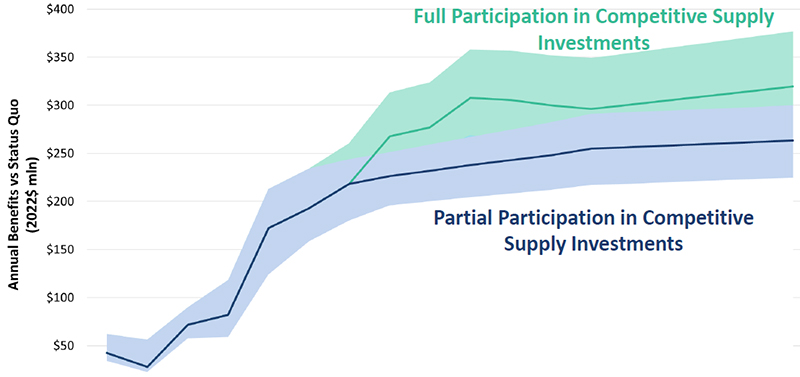
Participating in an RTO could provide South Carolina with benefits of up to $362 million per year, according to a report Brattle Group presented to a special joint legislative committee on Monday.
 Brattle Group estimates South Carolina ratepayers can save $25 million to $120 million in the near term and $150 million to $370 million in the long-term if the state transitions to full or partial use of competitive generation supplies. | Brattle Group
Brattle Group estimates South Carolina ratepayers can save $25 million to $120 million in the near term and $150 million to $370 million in the long-term if the state transitions to full or partial use of competitive generation supplies. | Brattle GroupThe report to the Electricity Market Reform Committee found that joining PJM would lead to the most benefits (up to $362 million per year), followed by South Carolina — and possibly some of its neighbors — forming a new organized market in the Southeast (up to $187 million). The report also covers a system like CAISO’s Western Energy Imbalance Market (as much as $25 million in net benefits) or setting up a joint dispatch agreement (JDA) between that state’s utilities that would save up to $11 million annually.
Duke’s two South Carolina utilities operate under a JDA, which could be expanded to include Dominion, Santee Cooper (a state-owned public utility) and others that serve the state.
South Carolina could also integrate with an existing RTO, but under a new governance model that would be similar to the Western EIM, with the addition of a day-ahead market and resource adequacy pooling.
Brattle said its savings projections were in line with other benefits studies around the country, which show 4 to 8% operational savings from RTO membership. When Louisiana joined MISO, it was able to cut its reserve margin from 18% to 12%, which is consistent with the savings projected in South Carolina.

All the scenarios include operational benefits because they let power flow more freely over a wider region, but joining or creating an RTO comes with additional investment cost savings from coordinating resource adequacy over a broader region, which enables lower reserves for the state.
No Loss of Reliability
At Monday’s hearing, Brattle principal and report co-author John Tsoukalis said that the lower reserve margin would still provide the same level of reliability.
“Everybody in the market can achieve the same level of reliability with a slightly reduced reserve margin,” he added.
The main reason joining PJM leads to more benefits than setting up a new Southeast RTO is that South Carolina’s immediate neighbors have similar supplies, so trading power would not bring the state’s utilities as much income as linking up to the more expensive market serving the Mid-Atlantic and Midwest, Tsoukalis said.
Committee members at the hearing asked questions about Brattle’s conclusions, and legislators will use the report to inform their decision on any changes to the state’s regulatory structure. Committee co-chair Sen. Tom Davis (R) said at the hearing that the committee must make recommendations to the full legislature by January.
Setting up a joint JDA, an EIM or a new RTO are all lengthy processes that would include coordinating with entities outside of South Carolina’s control.
Joining PJM is the most expeditious path to full RTO membership, with PJM in the past having taken on new members in as little as 18 months.
“Under this model, South Carolina would operate within all existing RTO market and governance structures, including the option to retain its vertically integrated and state-jurisdictional utility structure,” Brattle said in the report.
Brattle found the biggest benefits came to South Carolina when it worked with its neighbors on its decision, advising the legislature to especially reach out to North Carolina. Dominion Energy North Carolina is in PJM already, but the rest of the state is not in any market.
South Carolina is also considering retail market reforms, but Tsoukalis said that moving on wholesale reforms first would make the most sense as they will inform potential changes to its retail regulations.
The committee posted a document of comments on the study, and while the state’s utilities largely focused on technical findings, AARP South Carolina opposes joining an RTO, saying it bases its views on “the realities of RTOs after 25 years in states that have them.”
“Our members in Texas and California have suffered from power interruptions and higher electricity prices caused by the complicated new RTO-induced structures where no one is clearly in charge of keeping the lights (and air conditioning and heating) on,” AARP said.

